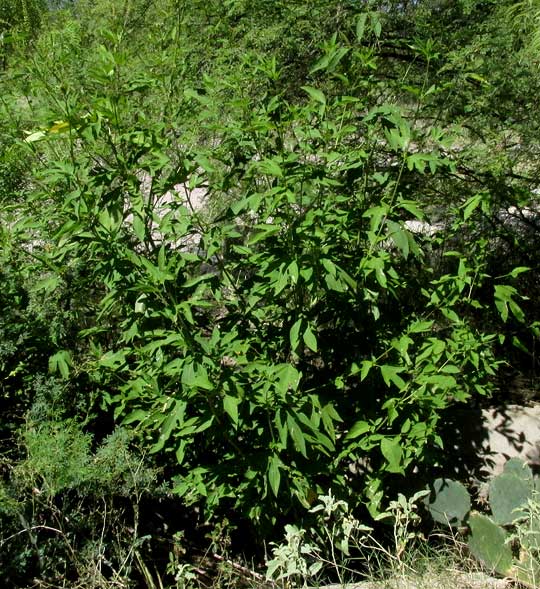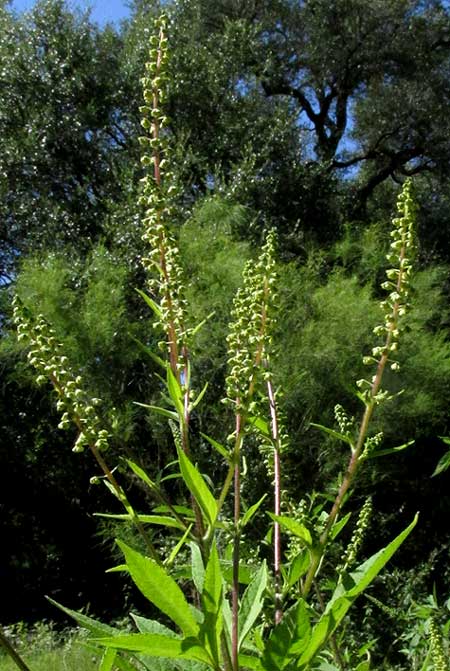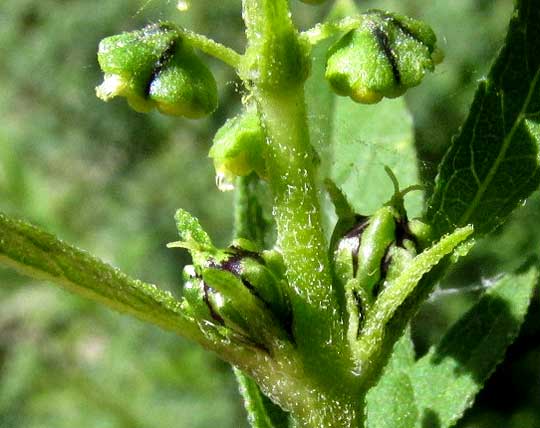Excerpts from Jim Conrad's
Naturalist Newsletter
from the August 31, 2014 Newsletter issued from the Frio Canyon Nature Education Center in the valley of the Dry Frio River in northern Uvalde County, southwestern Texas, on the southern border of the Edwards Plateau; elevation ~1750m (~5750 ft); N29.62°, W99.86°; USA
GIANT RAGWEED
Nowadays one of the first things my neighbor Phred does when he steps outside his air-conditioned house is to go through a fit of sneezing. One reason for that might be shown below:

That's Giant Ragweed, AMBROSIA TRIFIDA, which most of us have seen in weedy spots, especially moist ones. I hadn't expected it here because of the aridness, but you can see that the seven-ft-tall one (2m) in the picture stands next to a prickly pear cactus. Actually, Giant Ragweed is quite common in Cook's Slough Nature Park on Uvalde's south side, especially in shade and next to ponds. In the Dry Frio River Valley 35 miles to the north, on the Edwards Plateau southern slope, I've not seen one.
Though 22 ragweed species -- members of the genus Ambrosia -- are listed for North America, Giant Ragweed is easy to distinguish from all the others not only by its size but also for its large leaves which normally are deeply lobed with up to five "fingers," as shown below:

At WebMD.com one reads that "... most cases of hay fever are caused by an allergy to fall pollen from plants belonging to the genus Ambrosia -- more commonly known as ragweed." And Giant Ragweed produces prodigious amounts of pollen. The plant in the picture was topped with dozens of slender, pagoda-like, pollen-producing flowering heads, or racemes, as seen below:

Since ragweeds are members of the giant Composite or Daisy Family, each of those objects on a slender pedicel arising from the racemes' stems is a cluster of tiny male flowers. Below, you can see some tiny heads of male flowers:

Each little head is structurally like a daisy, in that each consists of a green, bowl-like "involucre" (held upside-down in ragweed racemes), inside which reside several individual male flowers, or florets. In our picture, most florets inside their involucres haven't opened yet to release pollen, but some have. All the florets in each involucre consist of nothing but stamens. Each pollen sac in every anther of every male flower contains thousand of pollen grains. It seems that Giant Ragweed produces much more wind-dispersed pollen than it can possibly need. I read that a single plant can produce 10 million pollen grains daily and more than a billion pollen grains during its life cycle.
So, where are the female flowers? If you look for them you can find them at the racemes' very bottoms, as seen below:

In the picture's top you see two nodding involucres bearing male flowers, but in the picture's lower half those blackish, eggfruit-like items topped with V-shaped stigmas are female flowers. The eggfruit-like things will mature into cypsela-type fruits -- dry, one-seeded fruits that don't split open at maturity. In the old days, ragweeds were thought to pollinate themselves, but now it's known that they're strongly self-incompatable. A plant's pollen may generously douse its own female flowers, but the male and female sex germs at the genetic level just can't get it together.
Unlike most weeds, ragweeds are native Americans, though they've become weedy in other countries. Giant Ragweed ranges all across southern Canada south through all of the US into northern Mexico, so the species' vitality and robustness must be admired.
Since Giant Ragweed is native, indigenous Americans had uses for it. The Cherokee used it medicinally for insect stings, hives, fever, and pneumonia, and the Iroquois used it to treat diarrhea. I read that it's been used successfully as a compost activator and as a cover in sheet mulch gardens. The stems are so thick and tough ,though, so a wood-chipping machine might be necessary for these latter purposes.